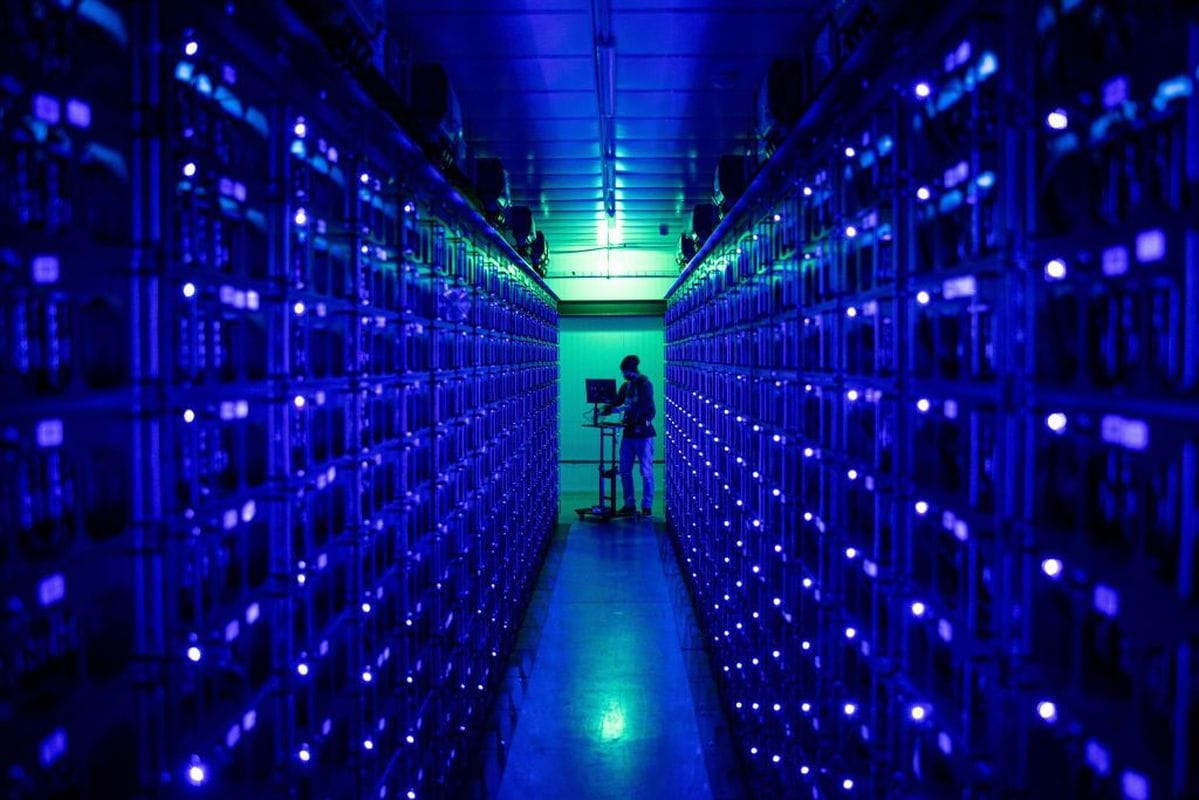The process of producing digital currencies is known as cryptocurrency mining. However, this should not be confused with the issue of money, as mining has distinct activities and responsibilities for the contractor. Most cryptocurrencies, in fact, are based on the notion of decentralization.
Read also: How to create your own blockchain
This means that all network transactions are performed by each user who willingly connects to the network, rather than by a single central authority, such as a known national or central bank. The system establishes and charges miners a cryptocurrency reward or a portion of it for a set number of processed transactions to encourage users to use their time and computer resources to process transactions.
However, not everything appears to be as straightforward as it appears at first look. Most cryptocurrencies use blockchain technology, which means that each transaction on the network contains information about all prior transactions since the digital currency was formed.
As a result, the difficulty of processing bitcoin transactions is always growing, and only the miner who completes the transaction first is rewarded. So mining isn’t a game or a speculative investment; it’s a real profession that necessitates some understanding; and it’s an investment that can provide both profit and loss.
Is it possible to gain money by mining cryptocurrencies?
When Satoshi Nakamoto introduced Bitcoin in 2009, transactions could be processed using a computer with average CPU power. However, when the popularity of cryptocurrencies grew, as did the amount of transactions done, the increasing complexity of computations necessitated the use of more powerful equipment, and calculations began to be performed on video cards.
In 2012, one computer was no longer sufficient to conduct network operations, ushering in the era of mining farms (objects connecting multiple graphics cards together), followed by ASIC pools (devices with numerous components, tailored to a certain algorithm for various coins).
As a result, the cost of the equipment required to mine cryptocurrencies successfully is constantly rising and can now approach tens of thousands of dollars. Furthermore, the operation of such devices consumes a lot of electricity and necessitates additional cooling of the system. Many digital currencies, on the other hand, have already reached their high and are now trading sideways, making them less appealing for investment.
So, if in the years of the birth of cryptocurrencies you managed to get your investments back in a few weeks, now it will take several years. And mining has become a serious investment, and its owner has to analyze many factors to make a decision: the dynamics and growth prospects of the cryptocurrency exchange rate, the complexity of its mining, the cost of the mining equipment purchased and its technique. Amenities, local tariffs etc.
And of course, investing in mining is a bit like a roulette wheel, as there have been cases where the price of a cryptocurrency has fallen several times over the course of a few days, while beginners, on the contrary, gained in value within a week. This increases the uncertainty of this investment direction.
Types of digital currency mining
Mining is separated into CPU mining, GPU mining, ASIC mining, cloud and browser mining, computer, laptop, and messaging mining, and so on, depending on the hardware and software used for mining, as well as the type of owner.
Mining of processors
Digging inside the processor (CPU) was in the news ten years ago, when the first cryptocurrencies were being developed. However, the CPU power required to process cryptocurrency transaction data contained in extended blockchain chains is no longer sufficient. And this form of mining is only considered for cryptocurrencies – market newcomers with a short history of operation and, as a result, a fast transaction processing speed.
Also, some cryptocurrencies, such as B. Monero, Dash, Litecoin, and others, have processing algorithms that are better suitable for mining on the processor. At the same time, analysts predict that the powerful processor will bring in no more than $ 30-50 each month in mining revenue.
In reality, depending on the processor clock frequency, the processor core can only do four or eight 32-bit operations per clock. Graphics cards built to process enormous volumes of graphics data, for example, can already handle 3,150 pieces. For the same time span, 32-bit operations were used. Mining using a graphics card (GPU) turns out to be a hundred times faster (and more profitable) than mining on a processor.
If you’ve already decided to start mining on the CPU, we recommend getting one with a good frequency and number of cores, a large cache, low power consumption, and the capacity to work with SSE2, AES encryption, among other things. Xeon processors are now the best option, however AMD or Intel devices (i3, i5, i7) are also viable options. However, don’t be too lazy to search forums for the features of the acquired CPU that will allow you to mine the cryptocurrency you want.
It’s also crucial to get a competent digital currency mining software. Some of them let you mine using both your CPU and graphics card at the same time. Wolf’s CPU Miner, Nheqminer, and CPU Miner are decent programs that may be downloaded for free via the Internet, such as Github.
Then you’ll need to set up an electronic wallet to receive the bitcoin you’ve mined. It must to work with the mining software. Create a file with the Fledermaus extension and begin mining after registering and synchronizing the wallet. It’s a file format that contains the extraction process’s main parameters. An ordinary notepad file can be used to perform this manipulation, which will then be saved in the bat format after the relevant code has been entered.
Mining with graphics processing units
Graphics card mining is one of the most popular and important methods of cryptocurrency mining these days because it necessitates a fast transaction processing speed. Finally, GPUs were created to process vast numbers of the same type of video data, similar to how digital currencies are mined. At the same time, it should be highlighted that full-fledged discrete video cards, rather than video chips built into laptop processors, are effective for such extraction.
Nvidia’s 1060, 1070, and 1080 TI, as well as AMD’s RX 470, RX 480, RX 570, and RX 580, are the finest graphics cards for mining Bitcoin and other cryptocurrencies in 2019.
It’s tempting to use special software to overclock your graphics card as much as possible, but this will void the card’s warranty and, at worst, cause a crash. As a result, it is critical to exercise caution and, at the very least, study acceleration program reviews in technical forums before proceeding. The MSI Afterburner accelerator is one of the better examples of this.
You can mine any money with your graphics card, however some are better suited because their algorithms are more GPU friendly. Because old algorithms aren’t designed to interact with video cards, they can take a long time to process. In addition, prominent cryptocurrencies such as Bitcoin, Litecoin, Dash, and Dogecoin will not benefit from the graphics hardware. Their transactions are already being processed by ASICs, which are very complicated computer gear designed to mine a certain cryptocurrency. Thousands of dollars are spent on this strategy.
CryptoNigh encryption-based cryptocurrencies like Monero, Bytecoin Electroneum, Equihash (Hush, ZCash, Bitcoin Gold), and Ethash are ideally suited for GPU mining (Ethereum, Ethereum Classic). Mining using a system of 4-6 graphics cards is recommended by experts for best profitability.
Mining with ASIC
There was a demand for specialized cryptocurrency mining equipment as mining became an industrial industry and rivalry increased – after all, only the miner who completed the deal first got the award. They were renamed a special purpose integrated circuit, or ASIC, which stands for “special purpose integrated circuit” in English.
It’s a chip that’s been fine-tuned to calculate a specific cryptocurrency’s mining algorithm. Modern cryptocurrencies, for example, are based on the calculations of the following algorithms: SHA-256 (Bitcoin, Bitcoin Cash, Syscoin, Namecoin), Ethash (Ethereum, Ethereum Classic, Ubiq), Equihash (Zcash, Komodo), X11 (Dash, Pura), Scrypt (Litecoin, B3Coin, Bitdeal), Blake (2b) (Decred, Siacoin), Blake (2b).
An ASIC excavator is made up of a printed circuit board, a memory module, connectors for connecting external devices, a fan, and a housing from a technological standpoint. ASIC mining is more efficient and uses less power than GPU mining.
ASICs were compact and connected to the main computer through a USB connector when they were first released. However, as the complexity of data processing grew, so did the size of the hardware ASIC. Industrial solutions, for example, are the size of a small table, cost thousands of dollars, consume over 600 watts of electricity, are noisier, and require additional cooling systems.
The highest quality ASIC equipment is offered by PinIdea, Bitmain, Ebang Communication and Baikal. When choosing an ASIC, you should first of all pay attention to the hash rate, which determines the performance of the equipment, i.e. the speed of future cryptocurrency mining. Today, the value of the indicator should be above 10 TH / s, preferably above 30 TH / s.
To install an ASIC device you will need:
- Connect the chassis and system control panel to a power source
- Connect the network cable to the router
- Check – the lights come on, the cooling system starts working
- Find the IP address of the ASIC device, for example using any browser, go to the router’s website
- Go to the miner’s web interface and select the work pool, microprocessor load frequency, and load power. If necessary, update the device software
- Save the settings and restart the ASIC hardware
- start mining
The ROI of ASIC devices depends on many factors. So you need to take into account: the hashrate (speed) of the equipment, the suitability and correctness of the parameters of the mining equipment, the complexity of mining and the price dynamics for a specific cryptocurrency.
Fortunately, there are a variety of online mining calculators available to assist you with the computations. To do so, open one of them and fill in some information. These can include the name of the cryptocurrency to be mined, the cost of hardware, the cost of electricity, and other fees, and you’ll get an estimate of the expected return in seconds. The current standard is a two-year payback period, with the most successful investments often returning within a year.
Cloud mining
Many miners have been left behind as the intricacy of bitcoin processing operations has increased, as has the expense of mining equipment. Mining, on the other hand, has always been a risky industry, as a quick decline in the price of a cryptocurrency can derail all business plans, as has happened several times in recent history. As a result of this difficulty, cloud mining has emerged, in which large industrial miners rent some of their equipment to tiny miners via the internet via specific applications.
To this goal, some investors have begun to establish huge mining firms (farms) in advantageous locations, such as coal mines in Iceland, where cooling devices are not a problem and they can rent some of the area’s power. world. While mining some of the most successful digital currencies, professionals from these organizations are examining the dynamics of cryptocurrency costs and hunting for prospective entrants.
As a result, cloud mining is the most profitable cryptocurrency mining investment in 2019. Some organizations offer a monthly return on investment of 20-70 percent, however this figure may fall as the value of the digital currency rises.
To connect to cloud mining you need:
- Evaluate the offers on the market and choose the best option
- Decide what computing power and algorithm (cryptocurrency) you need.
- Select the rental period. Usually, cloud miners offer a one-year contract, but there are also offers on the market for 6 months, 2 years or an indefinite period.
- Pay rent and transaction fees
- Receive regular statements from the cryptocurrency mining company.
Be careful when choosing a cloud company as there are scammers or just losers in the market. Some companies are just waiting for credulous enough users to get away with investor money. And no one can offer 100% protection against hacker attacks.
When selecting a cloud mining company, consider its transparency (the presence of a website, the publication of information and photos about the functions available on it, and the company’s experts’ blogs), the length of the company’s operation, the market, and the proposed cryptocurrency mining selection.
We can recommend the following companies based on their many years of expertise on the market in relation to bitcoin mining: Bitcoin is mined by IQ Mining, Ethereum is mined by CCG Mining and IQ Mining, Dogecoin is mined by Genesis Mining, and so on.



